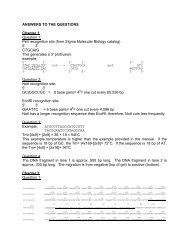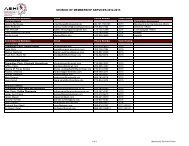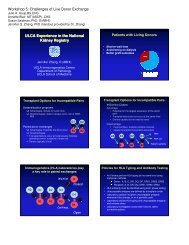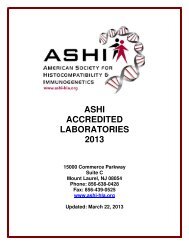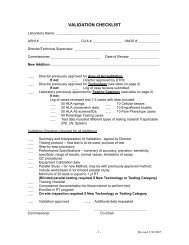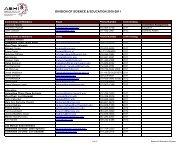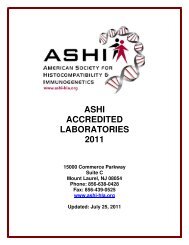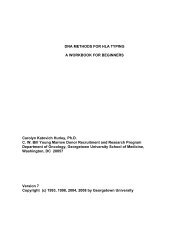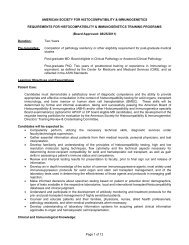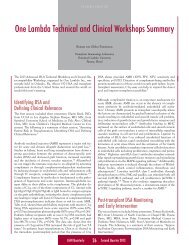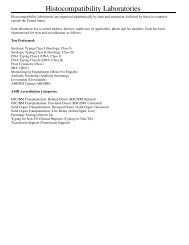Monday, September 27, 2010 2:00 PM - American Society for ...
Monday, September 27, 2010 2:00 PM - American Society for ...
Monday, September 27, 2010 2:00 PM - American Society for ...
- No tags were found...
You also want an ePaper? Increase the reach of your titles
YUMPU automatically turns print PDFs into web optimized ePapers that Google loves.
Methods: HLA antibody specificities were determined by Luminex SAB. A calculated panel antibodyreactivity (cPRA) was obtained <strong>for</strong> antibodies detected at MFI≥1<strong>00</strong>0, 2<strong>00</strong>0, 3<strong>00</strong>0, and 4<strong>00</strong>0 by using theUNOS cPRA calculator. Fifty sensitized patients who were tested <strong>for</strong> antibody specificity in the past yearwere calculated <strong>for</strong> cPRA and only patients (n=32) with HLA class I cPRA≥30% at MFI≥1<strong>00</strong>0 wereincluded in the final study.Results: The average cPRA was 77% at MFI≥1<strong>00</strong>0, 68% at MFI≥2<strong>00</strong>0, 62% at MFI≥3<strong>00</strong>0, and 54% atMFI≥4<strong>00</strong>0. The average probability of having a donor selected <strong>for</strong> a FCXM would increase from 23% atMFI≥1<strong>00</strong>0 to 46% at MFI≥4<strong>00</strong>0, which would double the size of the donor pool <strong>for</strong> sensitized patients. Forthe highly sensitized patients (cPRA≥80%, n=18), the average probability would increase from 5% atMFI≥1<strong>00</strong>0 to 21% at MFI≥4<strong>00</strong>0 resulting in an increase of >4X donor pool <strong>for</strong> highly sensitized patients.Conclusions: The increase cutoff from MFI≥1<strong>00</strong>0 to ≥4<strong>00</strong>0 may at least double the donor pool <strong>for</strong>sensitized patients. A final FCXM may be used <strong>for</strong> the definitive decision of transplant. Aggressive posttransplantmanagement may be considered <strong>for</strong> recipients of kidney allografts with unacceptable antigen(s)detected at a lower cutoff. The increase of the positive FCXM rate caused by increasing the MFI cutoff canbe investigated retrospectively.7-PHEART TRANSPLANTATION OF SENSITIZED PATIENTS.Dong-Feng Chen 1 , Nancy L. Reinsmoen 2 , Adella Clark 1 , Barbara O. Burgess 1 , Gregory F. Egnaczyk 1 ,Chetan B. Patel 1 , Carmelo Milano 1 , Joseph G. Rogers 1 . 1 Duke University Health System, Durham, NC,USA; 2 Cedars-Sinai Health Systems, Los Angeles, CA, USA.Aim: For sensitized heart transplant recipient, our center uses the virtual crossmatch (vXM) to selectcompatible donors. The unacceptable HLA antigens (UAG) were determined based on the specificity andtiters of HLA antibodies (Ab) detected by solid phase technologies. The aim of the study was to evaluatethe accuracy of vXM and its impact on the success of heart transplantation in sensitized recipients.Methods: Total 222 patients received heart transplants at our center between 2<strong>00</strong>5 and 2<strong>00</strong>9 were included.Sensitization was defined by presence of positive flow PRA and defined specificity of HLA Abs. Usingthese criteria, 62 (28%) were pre-transplant sensitized. For sensitized recipients needing emergenttransplant, titration test was per<strong>for</strong>med and anti-HLA Abs not detected at a dilution of 1:16 were considered“low titer” and were not considered in donor selection. Utilizing the principle of vXM, only donors withoutUAGs were used <strong>for</strong> non-emergent sensitized patients.Results: Among the 62 sensitized patients, 16 patients received organs with UAGs as determined by Absdetected in undiluted serum samples. 10 of these 16 patients had positive HLA XM by flow cytometry. Ofthese 10 positive XMs, 8 were expected due to the presence of weak Abs detected in evaluation seracollected prior to time of listing. In addition, there were 3 positive XMs which most likely were caused bynon-HLA Abs because no DSA were determined. Among the 62 sensitized recipients, 52 had an at leastone-year follow-up. The one-year survival rate <strong>for</strong> these 52 sensitized recipients was 94%, and <strong>for</strong> the 16recipients who received organs with UAGs was 93%.Conclusions: Based on these data, we conclude that the vXM used <strong>for</strong> heart donor selection in sensitizedpatients had a 95% (5 with unexpected positive XM among 62 sensitized) predictive validity. The one-yearoverall survival rate <strong>for</strong> patients received organs with low-titer UAGs was comparable to those receivedorgan without UAGs.8-PVARIABLE EXPRESSION OF C LOCUS ANTIGENS IN RELATIONSHIP TO FLOWCROSSMATCHING AND SAB TESTING.Steven R. De Goey, Deborah K. Falbo, Nancy A. Ploeger, Gandhi J. Manish. Laboratory Medicine andPathology, Mayo Clinic, Rochester, MN, USA.Aim: Identifying donor specific anibody (DSA) to HLA, using single antigen beads (SAB), is used inper<strong>for</strong>ming a virtual crossmatch (VXM) as a surrogate <strong>for</strong> an actual crossmatch (XM). DSA strength isdefined by bead fluorescence (MFI) and usually a single value is used as a cutoff. However, this does nottake into consideration the variable expression of HLA antigens on lymphocytes. As HLA-C has a variable



